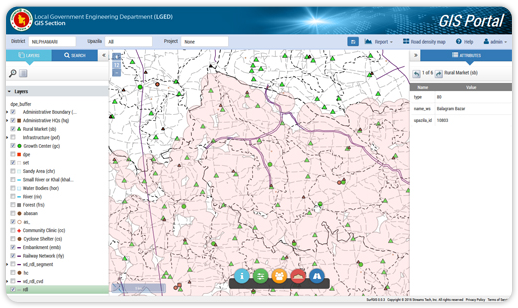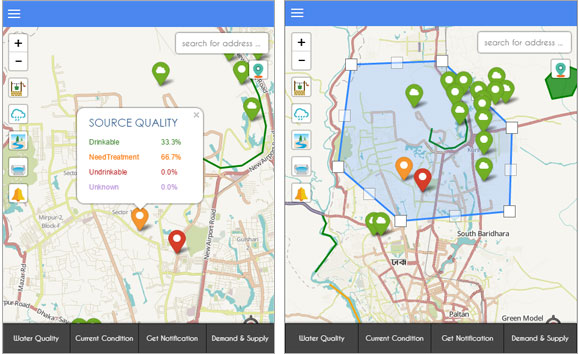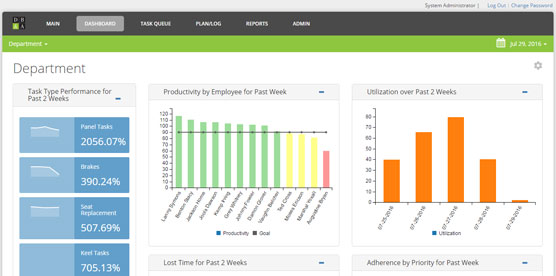Water and Environment
Extended Peer Review of Floodplain Results for the East Pasco Watershed
Pasco County, Florida, partnered with the Southwest Florida Water Management District (SWFWMD) to modernize flood maps covering the East Pasco Watershed. Streams Tech personnel were tasked with reviewing the modeling methods and results used to update the floodplain delineations, and to validate the accuracy of the digital flood maps created by the District’s Cooperating Technical Partner (CTP) tasked (under the National Flood Insurance Program (NFIP)). Streams Tech conducted a thorough assessment of the Inter-Connected Pond Routing (ICPR) model prepared by the prime consultant as well as the data originally used in preparing the Digital Flood Insurance Rate Map (DFIRM).
Freetown Stormwater Management Master Plan and Detailed Design, Sierra Leone
Streams Tech conducted a detailed study to develop the Stormwater Drainage Master Plan for Freetown, Sierra Leone. The lack of flood management measures and adequate conveyance capacity of the existing drainage system regularly caused flooding in the heavily urbanized areas. Streams Tech personnel installed hydro-meteorological equipment to collect data; processed an extensive array of satellite-based rainfall, topographic, and collected data in GIS; and expeditiously developed stormwater models using GeoSWMM and XPSWMM for the 50 square mile area. We assessed different flood control options, including cascaded detention ponds, lot-level storage facilities, restoration of natural watercourses, changes to land use planning, replacement of bridges and culverts, and relocation of settlements in the floodplains, and recommended effective measures to mitigate the flood risks.
Bacteria Total Maximum Daily Load (TMDL) Development for the Mattaponi River Watershed, Virginia
Streams Tech, Inc. developed the Total Maximum Daily Load (TMDL) for the Mattaponi River watershed to determine the sources of bacterial (E. coli) contamination for fourteen waterbodies and to find the allocations that would allow the waterbodies to meet Virginia’s Water Quality Standards. The study involved acquiring necessary data from various sources, mapping the data, quantitatively assessing the bacteria sources through watershed modeling, and developing scenarios that would solve existing water quality problems. We conducted extensive water quality modeling using EPA’s BASINS and HSPF models to simulate the fate and transport of bacteria in the runoff and streams, and created scenarios to demonstrate the impact of bacteria load reductions (by source) and the resulting instream bacteria concentrations. The TMDL watersheds spanned across four counties covering an area of 550 square miles between Richmond and Fredericksburg, Virginia. The TMDLs were approved by EPA and Virginia Water Control Board in 2016 following the submission of a detailed analysis and report.
Development of Nutrient TMDL for the Caloosahatchee River Watershed, Florida
The Caloosahatchee River originates in Lake Okeechobee, Florida, and flows west to the Gulf of Mexico at San Carlos Bay. The Caloosahatchee River and Estuary downstream of the Franklin Lock and Dam were listed as impaired for total nitrogen, which caused a high chlorophyll a concentration in the shallow tidal waters. The Total Maximum Daily Load (TMDL) study linked various pollutant sources in the 1,339 square mile watershed to instream water quality concentrations through hydrologic and water quality modeling using HSPF and established the reductions of pollutants that were necessary to achieve Florida’s Water Quality Standards. Streams Tech, Inc. personnel performed data analysis, setup, and calibration of the model, and conducted training sessions on HSPF modeling and TMDL development for the DEP staff and stakeholders. The watershed model incorporated groundwater pumping, irrigation return flows, many hydraulic structures, and distributed rainfall data. The time series output of flow and water quality constituents from HSPF runs were linked to a three-dimensional EFDC-based estuary model.
Bacteria Total Maximum Daily Load (TMDL) Development for Potomac River Tributaries, Virginia
Streams Tech, Inc. developed the TMDLs for Powell’s Creek, Quantico Creek, South Fork Quantico Creek, North Branch Chopawamsic Creek, Unnamed Tributary to Potomac River, Austin Run, Accokeek Creek, Potomac Creek and Potomac Run in Prince William and Stafford Counties, Virginia. Hydrologic Simulation Program-Fortran (HSPF), which is a watershed-based hydrologic and water quality model, was used to simulate the instream water quality conditions under varying scenarios of rainfall and bacteria loads. The ‘paired watershed’ approach, a hydrologic model calibration and validation technique pioneered by Streams Tech staff, was employed to develop a credible model in the absence of local stream gage data. The TMDLs were approved by EPA in 2013.
Development of the Hyco River Watershed Model, Virginia
Streams Tech, Inc. developed a watershed model using BASINS/HSPF for Hyco River, which flows from North Carolina into Virginia, and performed initial model setup (e.g. watershed delineation, land use reclassification, FTable generation, pre-processing of input data), weather data and WDM file preparation, hydrologic and water quality calibration, and validation of the model. The project involved an eight year simulation of flow and pollutant concentrations on an hourly basis at various locations to determine the assimilative capacity of stream reaches and was used to develop TMDL allocations for various impaired reaches of the watershed. The TMDLs were approved by EPA in 2015.
Water Distribution System Modeling, McAlester, Oklahoma
Streams Tech, Inc. developed a water distribution and management system model using EPANet for a US government facility in McAlester, Oklahoma, to evaluate the existing water network, determine the capacity and performance of the distribution system, and plan for the optimum sizing of new water mains and future development. The water distribution model took into account the citywide demands, site-specific demands, water storage facilities, physical dimensions and characteristics of the water mains, pumps, network interconnections and node elevations to simulate pipe flow hydraulics, including dynamic flow rates, head loss in pipes, and pressures across the distribution system. The model also helped in selecting the best location for a new storage tower, pump station and optimizing the flushing program.
Feasibility Study for Sustainable and Cost-Efficient Water Supply for Dhaka
Streams Tech supported Grontmij A/S in creating a comprehensive water distribution network model and analysis for Dhaka, the capital of Bangladesh and one of the most densely populated cities in the world. Streams Tech personnel developed a high resolution citywide Master Network Model by incorporating individual District Metered Area (DMA) models developed by different consultants under the Dhaka Water Supply Sector Development Project (DWSSDP). The model simulated 2015 and 2030 conditions to 1) assess the distribution of water produced by the Production Tube Wells (PTW) and the Surface Water Treatment Plants (SWTP), 2) identify the most critical PTW and SWTP sources, 3) evaluate the network demand for 2015 and 2030, 4) estimate the size of the transmission main for year 2030, 5) identify the major constraints and challenges in shifting the dependency from groundwater to surface water sources, and 6) recommend a number of suitable rehabilitation schemes.
Evaluation of the Stormwater System, Fort Bliss, El Paso, Texas
Streams Tech, Inc. identified the critical conveyance problems in the Ft. Bliss stormwater management system, which consisted of a series of drainage channels and pipes, storm water pump stations, and storm water retention ponds. Outflow from the system reaches the Rio Grande through the Municipal Separate Storm Sewer Systems (MS4) facilities in the City of El Paso. GIS data, which was derived from scanned AutoCAD images, site surveys, Light Detection and Ranging (LIDAR) surveys, and previous studies, were utilized in an advanced stormwater model based on EPA's SWMM to help identify the deficiencies of the stormwater management system and make recommendations. The model was used to evaluate the performance of the stormwater system under various design storms.
Four Mile Run Watershed Management Program Support
Four Mile Run is a tributary of the Potomac River and its watershed is one of the most heavily urbanized drainage basins in the Northern Virginia Region. The urbanization process replaced most of the watershed's natural streams with an elaborate network of storm sewers and resulted in substantial impervious surfaces. The Four Mile Run Watershed Management Program is designed to control increases in peak flow and the volume of surface water runoff due to projects in sensitive areas along the 20-square-mile watershed. Streams Tech maintains and updates the Four Mile Run SWMM Model, evaluates the impact of development and infrastructure projects, and make specific recommendations for compliance with the local stormwater management ordinances.
Prospective Hydro-Electricity Generation in Southeast Bangladesh
Streams Tech, Inc. carried out a hydropower feasibility study to identify viable sites for both reservoir and the run-of-river type hydroelectric plants along the Sangu, Matamuhuri, and Bakkhali Rivers. Nineteen sites were identified and evaluated in this World Bank-sponsored project. Streams Tech estimated the hydroelectric power potential at each site. Satellite-based rainfall data, digital topographic data, and advanced hydrologic models were utilized to overcome challenges presented by the lack of local data. Technical features of the project include GIS-based topographic analysis to identify the locations of significant hydraulic head, long-term hydrologic modeling to estimate stream flow time series, optimization of reservoir storage, development of storage-frequency curves, generation of flow-duration and energy-duration curves, calculations of the maximum power and energy potential, and the mapping of inundation zones.
Development of a Procedure Manual for the Total Maximum Daily Load Program
Streams Tech, Inc. developed a Procedure Manual for Virginia Department of Environmental Quality's (DEQ) Total Maximum Daily Load Program to provide guidance to DEQ staff and contractors on data sources, data processing, reporting requirements, modeling techniques, minimum requirements, and the TMDL end points. Section 303(d) of the Clean Water Act and the EPA’s Water Quality Planning and Management Regulation (40 CFR Part 130) require states to develop TMDLs for water bodies that do not meet the water quality standards. Developing TMDLs is a complex process involving a detailed hydrologic analysis; a complete accounting of sources, fate, and transport of pollutants; generation of allocations that would meet the water quality standards; and compliance with regulatory and TMDL program requirements.
Groundwater Management for John F. Kennedy (JFK) International Airport, New York.
Streams Tech personnel worked as an expert to support groundwater management during the construction of a passenger tunnel at JFK International Airport. He oversaw groundwater control during tunnel excavation to contain the migration of a large plume of groundwater contaminant near the excavation site. Without groundwater management, dewatering during the excavation would speed-up the migration of the plume towards the excavation. He worked on the selection, design, and installation of extraction-well (EW) configuration and a monitoring-well (MW) groundwater management techniques. The EW configuration was used to dewater the groundwater, and the MW configuration was used to monitor the plume migration. EW/MW data were collected from the site and analyzed to develop real-time groundwater management strategies.
GIS Based Services:

GIS Portal


WaterMap
The Water Map has been developed with an aim to provide a sustainable solution for the worldwide potable water resource management. Emphasizing on the crowd-sourcing, this app primarily connects mass people (non-technical) in contributing information for identification of the water sources, quality indicators and water use information. However, it also provides a base platform for the technical users to incorporate relevant water information.

Key features:
- Nearby potable water source search or detection at local level
- View and analyze water source accessibility and quality
- Evaluate source capacity and demand-supply condition
- Contribute to add or edit water source data used by the app
- Monitor and notify water source condition to the concerned authority
- Detect potential source hazards

eMOS (e-Management Operating System)
eMOS is a web based planning and monitoring application. It provides an easy way to create plans and enter actual data. It allows an organization to configure its departments, teams, members and resources with few clicks. eMOS dashboard and rich set of reports help not only to evaluate performance but also to increase efficiency. Instead of focusing on processes, eMOS allows the organization to focus on people and ensures their collaboration in attaining the company’s objectives. It optimizes resource allocation and ensures proper time management thereby improving the company’s productivity and streamlining the business processes. Streams Tech is providing complete software development, quality assurance and maintenance support for eMOS.

Key features:
- Activity plan/log and reporting
- Dynamic dashboard creation from widget gallery
- Data feed development for analytics
- Customized role based access control
- Fully customized role based access control
- Organization wise departments, teams and resource set-up
- Graphs and metrics can be customized with preferred data
Our Mobile Applications:

SytePad


LLoydsList

BI Services: Data Processing and Analysis

Gapminder
Gapminder is a non-profit venture promoting sustainable global development and achievement of the United Nations Millennium Development Goals by increased use and understanding of statistics and other information about social, economic and environmental development at local, national and global levels. We are like a modern “museum” that helps making the world understandable, using the Internet.
Gapminder is currently using a hand-made relational dataset built in an extremely unconventional manner with linked Google Spreadsheets maintained by multiple people. The scope of this project is to collect & merge publicly available datasets over internet with the existing Gapminder data.
Few of the data providers are:
- World Bank (http://databank.worldbank.org)
- International Monetary Fund (https://www.quandl.com/data/ODA/d ocumentation/overview)
- UNICEF (http://data.unicef.org) UNDP (http://hdr.undp.org/en)
- UNDP (http://hdr.undp.org/en)